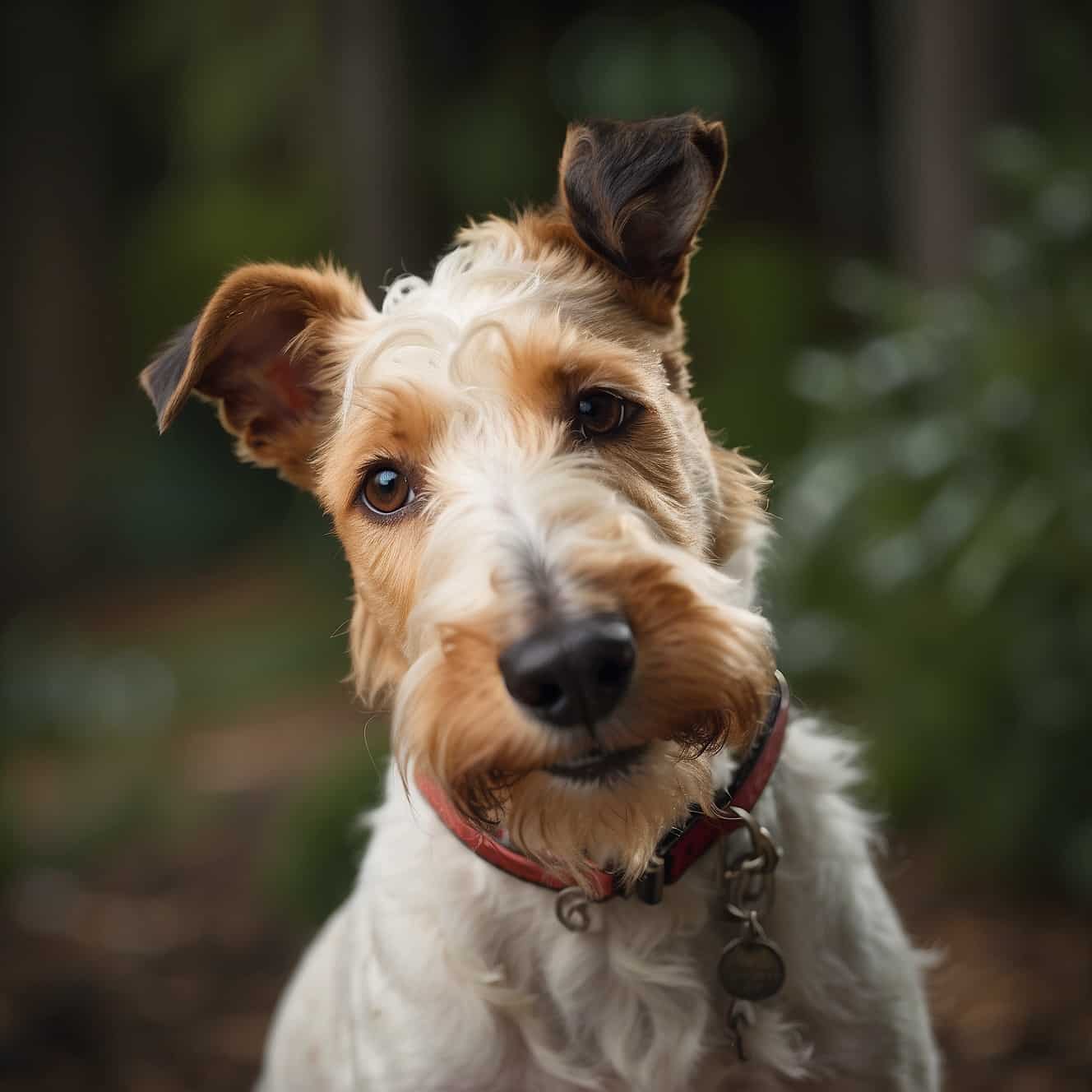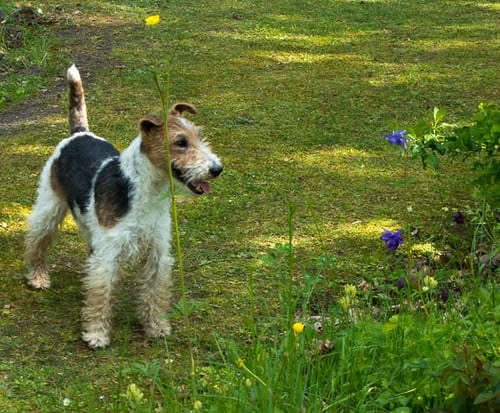Wire Fox Terriers are a breed with a distinctive, rough coat and a lively spirit. Discover their history, the care they need for their unique coat, and the energetic traits that make Wire Fox Terriers cherished companions.

| Category (Explanation) | Breed Information |
|---|---|
| Year of Breed Conception | 19th century |
| Country of Origin | United Kingdom |
| Weight (lbs & kg) (Male) | 18-20 lbs (8-9 kg) |
| Weight (lbs & kg) (Female) | 16-18 lbs (7-8 kg) |
| Coat Type | Dense, wiry, and twisted |
| Color Variations | Predominantly white with black or tan markings |
| Shedding Level (Low, Moderate, High) | Low to Moderate |
| Height (cm & in) | 15.5-16 inches (39-41 cm) |
| Breed Size | Small to Medium |
| Trainability (Low, Moderate, High) | Moderate |
| Mental Needs (Low, Moderate, High) | Moderate |
| Intelligence Level (Low, Moderate, High) | High |
| Energy Level (Low, Moderate, High) | High |
| Agility (Low, Moderate, High) | High |
| Loyalty (Low, Moderate, High) | High |
| Playfulness (Low, Moderate, High) | High |
| Exercise Needs | Regular exercise and mental stimulation |
| Guarding Proficiency (Low, Moderate, High) | Low |
| Sociability with Children (Low, Moderate, High) | High |
| Barking Level (Low, Moderate, High) | Moderate |
| Digging Tendency (Low, Moderate, High) | Moderate |
| Destructive Behavior (Low, Moderate, High) | Moderate |
| Drooling Level (Low, Moderate, High) | Low |
| Obedience Level (Low, Moderate, High) | Moderate |
| Apartment Friendly (Yes/No) | Can adapt to apartment living with sufficient exercise |
| Inherent Prey Drive | High |
| Physical Risk to Others (Low, Moderate, High) | Low |
| Travel Fatality Risk (Low, Moderate, High) | Low |
| Allergen Potential | Low |
| Health Concerns (List of Common Health Concerns) | Legg-Calvé-Perthes Disease, Lens Luxation |
| Average Life Expectancy (Life Expectancy in Years) | 12-15 years |
Woof Mastery is reader supported and our articles may contain affiliate links.
Instead of running third party ads that we have no control of we only use links from high-quality companies we are directly partnered with. Making use of these links come at no cost to you our reader, and in many cases have the extra benefit of discounted rates or sign up bonuses.
If you’re interested you can read more about our affiliate policy here.
We appreciate your support and always insure that the products and services we recommend are high-quality, helpful and relevant to the subject at hand!
Wire Fox Terriers are a breed with a distinctive, rough coat and a lively spirit. Originating in England, they were also bred for fox hunting, using their wiry coat to protect them in the field. Over time, Wire Fox Terriers transitioned from hunting dogs to cherished family pets. Their energetic and spirited nature, combined with their distinctive appearance, has made them popular companions for those who appreciate their tenacity and charisma.

Wire Fox Terriers are special for their distinctive, rough coat and a lively spirit. Discover their history, the care they need for their unique coat, and the energetic traits that make Wire Fox Terriers cherished companions. Their unique coat and spirited nature make them special among terrier breeds, adding a touch of individuality to the lives of their owners.
Wire Fox Terriers have a traditional role closely tied to their history as hunting dogs. Originating in England, their primary purpose was to assist in fox hunting. Their task was to locate and flush out foxes from their dens, working alongside hunters in the field. Their distinctive rough coat and lively spirit made them well-suited for this role. While the practice of fox hunting has declined, Wire Fox Terriers continue to display their energetic and spirited traits as cherished family pets, maintaining their heritage as skilled hunting companions.
Wire Fox Terriers have distinctive coats and lively spirits. They are known for their wire-haired appearance and playfulness. These terriers can be affectionate and make great companions. They require training and socialization to ensure they are well-behaved and loving members of the family.
Wire Fox Terriers are a breed with a distinctive, rough coat and a lively spirit. They are typically affectionate and confident dogs. However, their strong prey drive and hunting instincts may require careful management. Training and socialization can help them become well-rounded pets. They are often playful and enjoy an active lifestyle.
Wire Fox Terriers are small dogs with a distinctive, rough coat that’s predominantly white with black and/or tan markings. They have a well-proportioned body with a flat skull, small dark eyes, and V-shaped ears that fold forward. Wire Fox Terriers have a short, straight tail and strong, straight legs. They have an energetic and confident gait, reflecting their lively and spirited nature.
Wire Fox Terriers have a distinctive rough and dense coat that is mostly white. They may have black or brown markings, especially on the head and ears. The wire texture of their coat adds to their unique appearance and helps them excel as working terriers.
Wire Fox Terriers have a distinctive wire-haired coat that is primarily white with black or brown markings. Their rough, dense coat adds to their spirited and active appearance.
Wire Fox Terriers have a low shedding level. They have a distinctive wire-haired coat that requires regular grooming to maintain its texture and prevent matting. Brushing helps manage shedding and keeps their coat healthy. While they shed minimally, attention to their grooming needs and occasional grooming sessions contribute to reduced shedding. Overall, Wire Fox Terriers are considered to be a breed with low maintenance in terms of shedding.
Wire Fox Terriers have a wiry, dense coat that requires more grooming attention to maintain its texture.
Brushing: Regular brushing, at least 2-3 times a week, is necessary to remove loose hair and prevent matting. Use a slicker brush or a brush specifically designed for wire-haired coats.
Stripping: Wire Fox Terriers may require hand-stripping or plucking to maintain the characteristic texture of their coat. This is typically done by a professional groomer.
Bathing: Occasional baths, using a mild dog shampoo, help keep the coat clean. Thoroughly rinse and dry after the bath.
Ears: Regularly check and clean their ears to prevent wax buildup or infections. Use a damp cotton ball or a veterinarian-recommended ear cleaning solution.
Nails: Keep their nails trimmed to a comfortable length, as long nails can cause discomfort and affect their gait.
Teeth: Brush their teeth regularly to maintain good oral hygiene. Dental chews or toys can also be beneficial.
Eye Care: Monitor their eyes for signs of irritation or discharge. Clean the eye area with a damp cloth if necessary.
Wire Fox Terriers have a high activity level. These energetic and intelligent terriers require regular exercise and mental stimulation to stay happy. Daily walks, playtime, and interactive activities are important for their well-being. Wire Fox Terriers may excel in activities such as agility and obedience. Their strong prey drive makes interactive play, such as fetch, enjoyable. Regular exercise helps prevent boredom-related behaviors, and providing them with puzzle toys and challenging activities contributes to their mental well-being.
Wire Fox Terriers are known for their intelligence, marked by problem-solving abilities, adaptability, and a desire to please their owners. They respond well to positive reinforcement training methods and can learn a variety of commands and tasks. Their adaptability allows them to thrive in different living environments. Historically, Wire Fox Terriers were skilled in roles such as hunting and vermin control, showcasing social intelligence by forming strong bonds with their families. While they may not top the charts in terms of obedience, their intelligence makes them excellent companions and working dogs. Training, socialization, and mental stimulation contribute to their well-rounded and obedient nature.
American Staffordshire Terriers thrive on mental stimulation. Engage them in activities that challenge their minds, such as puzzle toys, obedience training, or interactive games.
Social Interaction: They are social dogs and need regular interaction with their human family members. Loneliness can lead to anxiety or depression, so provide them with companionship and attention.
Exercise: Physical activity is not just for their bodies; it also benefits their mental health. Regular exercise helps reduce stress and anxiety.
Training and Obedience: American Staffordshire Terriers benefit from obedience training, which not only provides mental stimulation but also reinforces their bond with their owners. Consistent, positive-reinforcement training is effective in shaping their behavior.
Routine and Structure: Dogs, in general, thrive on routine and structure. Establishing a predictable daily routine can help them feel secure and reduce anxiety.
Affection and Attention: Show affection and spend quality time with your American Staffordshire Terrier. They are known for their loyalty and need for human companionship.
Socialization: Early socialization is crucial to help them become well-adjusted dogs. Expose them to different people, animals, and environments to build their confidence.
Safe Environment: Create a safe and comfortable environment at home where they can relax and feel secure. Provide a designated space for them to retreat to if they need alone time.
Consistency: Consistency in training and daily routines helps them feel more secure and confident in their environment.
Enter The Woof Mastery

Before bringing a Wire Fox Terrier into your home, it’s important to understand their needs and characteristics. These dogs are known for their intelligence, energy, and lively nature. Regular exercise and mental stimulation are essential to keep them happy and prevent boredom. Training and socialization should start early to ensure they grow into well-mannered companions. Potential owners should be prepared for grooming needs and committed to providing a loving, active environment for these intelligent and spirited dogs.
Wire Fox Terriers, with their distinctive coat and friendly demeanor, generally pose a low risk to others. Proper socialization and training contribute to positive interactions. Responsible ownership, understanding individual temperament, and adherence to local regulations play crucial roles in ensuring a well-behaved Fox Terrier (Wire).
Wire Fox Terriers are known for their energetic and alert nature. They can be good with children, but supervision is important during play. Early socialization and positive reinforcement training contribute to positive interactions. Teaching children how to approach and interact with the dog is important.
Wire Fox Terriers are generally good swimmers. Their energetic and playful nature may make them enjoy water activities. Introduce them to water gradually and observe their comfort level. Always prioritize safety and use a canine life vest if needed, especially in situations where they may be at risk of fatigue.
Wire Fox Terrier puppies are intelligent and lively, and positive training practices contribute to their development into well-behaved and happy adult dogs.
Wire Fox Terriers are known for being alert and may bark to alert their owners or express themselves. While they can be vocal, excessive barking is not a common trait. Proper training and socialization contribute to a well-behaved and appropriately vocal Fox Terrier (Wire).
Wire Fox Terriers are adaptable and can thrive in various living conditions. They do well in homes with yards where they can play and explore. Regular exercise and mental stimulation are important for their well-being. Wire Fox Terriers can adapt to apartment living with consistent exercise. They thrive on social interactions and enjoy being part of the family. Early training and socialization contribute to a well-behaved Wire Fox Terrier.
Wire Fox Terriers are generally adaptable to travel conditions. Ensure they are securely restrained in the vehicle using a crate or a suitable seatbelt harness. Monitor for signs of stress or discomfort and provide breaks for exercise. Familiar items and positive reinforcement can contribute to a positive travel experience for Wire Fox Terriers. Plan for regular breaks during long journeys to ensure their well-being.
Wire Fox Terriers may be prone to certain health concerns, as is common with many small breeds. While not all individuals will experience these issues, it’s important for Wire Fox Terrier owners to be aware of potential health problems and work with veterinarians to maintain their pets’ well-being. Common health concerns in Wire Fox Terriers include:
Regular veterinary check-ups, a balanced diet, proper exercise, and responsible breeding practices can help mitigate some of these health concerns. It’s crucial for Wire Fox Terrier owners to work closely with their veterinarians to monitor their pets’ health and address any issues promptly.
Proper nutrition is crucial for the health and well-being of Wire Fox Terriers. Here are some nutritional habits and best practices to consider for this breed:
Breed-Specific Laws (BSL): Fox Terriers (Wire) may be subject to breed-specific laws (BSL) in certain areas. These laws are often enacted at the local or municipal level and can vary widely from one jurisdiction to another.
Types of Restrictions: The specific restrictions imposed on Fox Terriers (Wire) under BSL can include mandatory spaying/neutering, special licensing, liability insurance requirements, muzzling in public, and, in some cases, bans on ownership. The severity of these restrictions depends on local regulations.
Rationale for BSL: BSL is typically implemented based on concerns about public safety and perceived risks associated with specific breeds, often due to incidents involving dog attacks. While Fox Terriers (Wire) are not inherently aggressive, they can be affected by BSL due to their physical resemblance to breeds that are sometimes included in these laws.
Controversy: It’s important to note that BSL is a controversial topic. Critics argue that it unfairly targets breeds rather than addressing individual dog behavior and that responsible ownership and training should be emphasized instead of breed-specific restrictions.
Local Regulations: To determine if there are breed-specific laws or restrictions regarding Fox Terriers (Wire) in your area, you should check with your local animal control or government authorities. Be aware of and comply with any local regulations to ensure that you are in compliance with the law while owning a Fox Terrier (Wire).
Woof Mastery is reader supported and our articles may contain affiliate links.
Instead of running third party ads that we have no control of we only use links from high-quality companies we are directly partnered with. Making use of these links come at no cost to you our reader, and in many cases have the extra benefit of discounted rates or sign up bonuses.
If you’re interested you can read more about our affiliate policy here.
We appreciate your support and always insure that the products and services we recommend are high-quality, helpful and relevant to the subject at hand!
Myth 1: Wire Fox Terriers are Hyperactive and Uncontrollable
Myth 2: They are Not Suitable for Families
Myth 3: They Require Excessive Grooming
Myth 4: They are Aggressive Towards Strangers
Myth 5: They are Too Small for Outdoor Activities
Myth 6: They are Prone to Excessive Barking
Myth 7: They are Not Intelligent
Myth 8: They Cannot Live in Apartments
Myth 9: They are Prone to Behavioral Issues
Myth 10: They are Not Good with Children
These myths emphasize the importance of understanding individual dog behavior and the influence of training and socialization. Wire Fox Terriers, like any breed, can thrive as wonderful pets when given the right care and attention.
Famous Wire Fox Terrier owners include:
King Edward VII: King Edward VII of the United Kingdom had a Wire Fox Terrier named Caesar, who was known for his loyalty and accompanied the king in various royal activities.
The Wire Fox Terrier has cultural significance in various contexts:
The Wire Fox Terrier, known for its distinctive coat, gained popularity in the 19th century. While there may not be a single most famous historical owner, Wire Fox Terriers were favored by individuals who appreciated their lively and spirited nature.
Wire Fox Terriers, like many breeds, have encountered challenges over the years. Some notable challenges include:
The Wire Fox Terrier is a terrier breed known for its wiry coat and energetic personality. It is believed to have been developed from a combination of terrier breeds, including:
Wire Fox Terriers, with their distinctive appearance and spirited personality, make charismatic family companions. Known for their loyalty and affectionate nature, they form strong bonds with their owners. Their moderate size and wiry coat add to their charm. Wire Fox Terriers thrive on interaction and engage actively in play. With proper training and socialization, they become devoted members of the family, bringing energy and enthusiasm to the household.